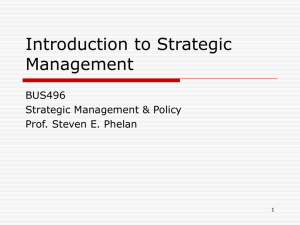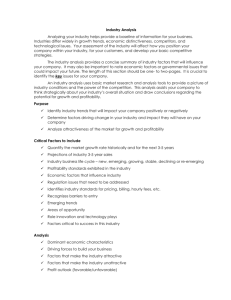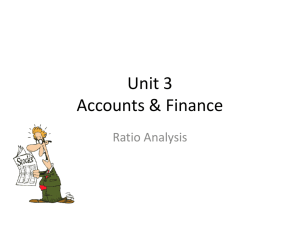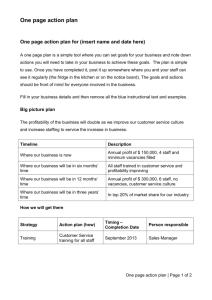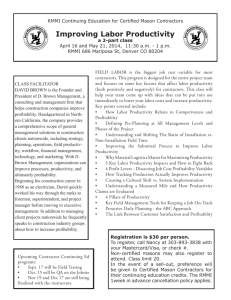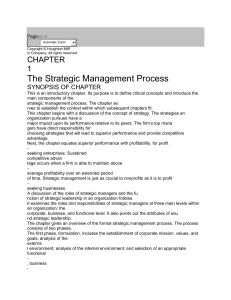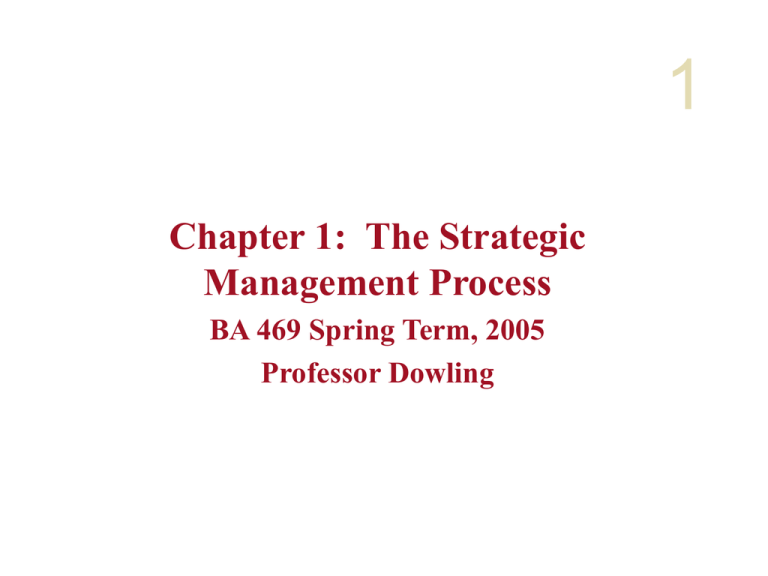
1
Chapter 1: The Strategic
Management Process
BA 469 Spring Term, 2005
Professor Dowling
Why do some organizations succeed
while others fail?
• Strategy
– An action managers take to achieve one or more of
an organization’s goals
• Strategic management process
– The process by which managers choose a set of
strategies that will allow a company to achieve
superior performance
1-2
Superior Performance and Competitive
Advantage
• Profitability
– A measure of a company’s return on its invested
capital
• Superior performance
– One company’s profitability relative to that of
other companies in the same or similar business or
industry
1-3
Firm-Specific Performance and
Profitability
• Competitive advantage
– A firm’s profitability is greater than the average
profitability for all firms in its industry
• Sustained competitive advantage
– A firm maintains competitive advantage for a
number of years
• Business model
– Management’s model of how strategy will allow
the company to gain competitive advantage and
achieve superior profitability
1-4
Industry Structure and Profitability
Return on Invested
Capital in Selected
Industries,
1997-2001
Data Source: Value Line Investment Survey
1-5
Strategic Managers
• General managers
– Responsible for overall company performance or
divisional performance
• Functional managers
– Responsible for supervising a particular task or
operation
1-6
Levels of Strategic Management
1-7
The Strategic Planning Process
1. Select the corporate mission and major corporate
goals
2. Analyze the external competitive environment to
identify opportunities and threats
3. Analyze the organization’s internal environment to
identify its strengths and weaknesses
4. Select strategies that build on the organization’s
strengths and correct its weaknesses in order to take
advantage of external opportunities and counter
external threats
5. Implement the strategy
1-8
Main
Components of
the Strategic
Planning Process
1-9
Mission Statement
• A description or declaration of why a company
is in operation
• Provides the framework or context within
which strategies are formulated
• Has 3 main components:
– Mission or vision
– Values or guiding standards that drive and shape
the actions and behavior of employees
– Major goals or objectives
1 - 10
The Mission or Vision
• What the company is trying to achieve over the
medium to long term
• The Boeing Company in 2016:
– “People working together as a global enterprise for
aerospace leadership”
• Microsoft:
– “To empower people through great software, any
time, any place, on any device”
1 - 11
Abell’s Framework for Defining the
Business
Source: D. F. Abell, Defining the Business: The Starting Point of Strategic
Planning (Englewood Cliffs, Prentice Hall, 1980), p. 7.
1 - 12
Values
• How managers and employees should conduct
themselves
• Organizational culture
– The set of values, norms, and standards that control how
employees work to achieve an organization’s mission and
goals
– Often seen as a source of competitive advantage
• In high-performing organizations, values respect the
interests of key organizational stakeholders.
1 - 13
Values at Nucor
• “Management is obligated to manage Nucor in such a
way that employees will have the opportunity to earn
according to their productivity.”
• “Employees should be able to feel confident that if
they do their jobs properly, they will have a job
tomorrow.”
• “Employees have the right to be treated fairly and
must believe that they will be.”
• “Employees must have an avenue of appeal when
they believe they are being treated unfairly.”
1 - 14
Values at Texas Instruments
Source: http://www.ti.com/corp/docs/company/vision.shtml. Accessed 10/25/02. Copyright © 1995-2002
Texas Instruments Incorporated. All rights reserved. Reprinted by permission.
1 - 15
Major Goals and Objectives
• Goal: A desired future state or objective
• Four main characteristics of well-constructed
goals:
–
–
–
–
Precise and measurable
Address crucial issues
Challenging but realistic
Specify a time period
1 - 16
Profitability
• Maximizing returns to shareholders
• Importance of balancing short-term returns
with long-term profitability
• Pressures to maximize short-term profitability
may result in unethical behavior
1 - 17
External and Internal Analysis
• External analysis
– Identify strategic opportunities and threats
• Industry environment
• National environment
• Socioeconomic or macroenvironment
• Internal analysis
– Identify organizational strengths and weaknesses
– Sources of competitive advantage: superior
efficiency, quality, innovation, and responsiveness
to customers
1 - 18
SWOT Analysis and the Business Model
• Identifying strategies to align a company’s
resources and capabilities to its environment in
order to create and sustain a competitive
advantage
–
–
–
–
Functional-level strategy
Business-level strategy
Global strategy
Corporate-level strategy
1 - 19
Strategy Implementation
• After choosing strategies, managers must put
them into action.
• The feedback loop—strategy is ongoing.
Managers must monitor and reevaluate for the
next round of strategy formulation and
implementation.
1 - 20
Strategy as an Emergent Process
• Strategy making in an unpredictable world
• Strategy making by lower-level managers
• Serendipity and strategy
1 - 21
Intended and Emergent Strategies
• Intended strategies
– Strategies an organization plans to put into action
• Emergent strategies
– Unplanned strategies
• Realized strategy
– The product of whatever intended strategies are
actually put into action and of any emergent
strategies
1 - 22
Emergent and Deliberate Strategies
Source: Adapted from H. Mintzberg and A. McGugh, Administrative Science Quarterly, Vol. 30. No. 2,
June 1985.
1 - 23
Strategic Planning in Practice
• Scenario Planning
• Involving Functional Managers
– Avoiding the ivory tower approach
– Perceiving procedural justice
• Strategic Intent
– Avoiding the fit model, which focuses too much on
the current state
– Setting ambitious goals that stretch a company and
finding ways to build to attain those goals
1 - 24
Strategic Leadership
•
•
•
•
•
•
Vision, eloquence, and consistency
Commitment
Being well informed
Willingness to delegate and empower
The astute use of power
Emotional intelligence
1 - 25
Challenges to Strategic Decision Making
• Cognitive biases
–
–
–
–
–
Prior hypothesis bias
Escalating commitment
Reasoning by analogy
Representativeness
Illusion of Control
• Hubris hypothesis
• Groupthink
1 - 26

